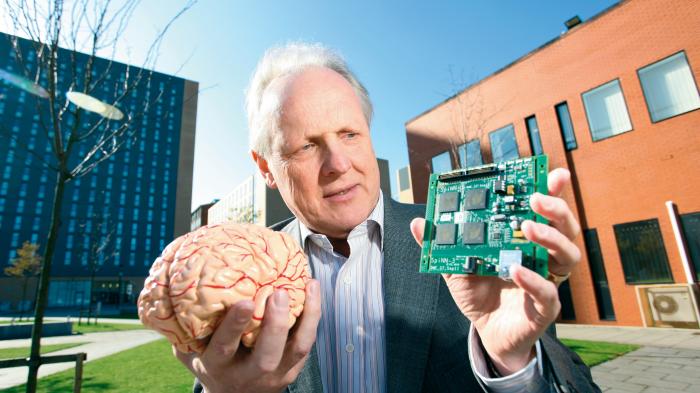Steve Furber from the University of Manchester is working on processors that are as efficient as the human brain.
Researchers develop novel electronic brain
Deep learning and AI specialized accelerator chips are just the beginning. The next generation of neuromorphic hardware is expected to come a good deal closer to the brain.
The currently so successful deep neuronal networks follow the principles of biological nervous systems. Neurons receive signals via synapses, calculate them and send the result to other neurons. They are built in layers, and they learn by changing the efficiency with which synapses transmit the impulses. So far, so brain-like.
Nevertheless, artificial neural networks are immensely simplified images of what neuroscientists observe in brains, reports Technology Review in its April issue. Minds are much more networked, and they send impulses back and forth between their layers. Moreover, real neurons are not one-dimensional integration units, but spatially extended beings with branches full of synapses. And they not only work digitally but also integrate information in analog form.
Connectivity at the brain level
“A network with twelve layers and strong feedback can map a network with 100 layers without feedback,” says Steve Furber of the University of Manchester. “But no one knows how to analyze a network with such strong feedback.” He has now built the SpiNNaker network (Spiking Neural Network Architecture). It is intended to offer brain researchers and AI researchers a platform for researching highly networked systems. “The special thing about SpiNNaker is that it allows us to create connectivity at the brain level,” says Furber.
The system is a monster of one computer: 600 boards with 48 ARM chips each with 18 computer cores per chip: makes about half a million computer cores. Each chip simulates 16,000 neurons – together they affect 460 million neurons with a total of 460 billion synapses. Communication in this network is entirely asynchronous. Each chip follows its clock and processes incoming spikes as soon as it registers them.
Blueprints for a neural network
However, SpiNNaker did not have a predefined task. The sponsors of the Human Brain Project only demanded that Furber build a highly networked, spike-based system with at least half a million neurons and then make it publicly available. Since mid-2016, anyone who wants to send blueprints for a neural network to SpiNNaker via the Internet. Some research groups have even had circuit boards with SpiNNaker chips delivered by post to implement neural networks for their robots. Such as the “SpOmnibot” of the Technical University of Munich. All of its information processing, from visual input to control signals to the wheels, is performed by SpiNNaker chips.
